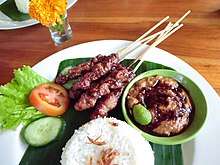Peanut sauce
Peanut sauce, satay sauce, bumbu kacang, sambal kacang, or pecel is a sauce made from ground roasted or fried peanuts, widely used in cuisines worldwide.[2]
Peanut sauce with vegetables in pecel | |
| Alternative names | Satay sauce, bumbu kacang, sambal kacang, pecel |
|---|---|
| Type | Condiment |
| Place of origin | Indonesia[1] |
| Serving temperature | Room temperature |
| Main ingredients | Ground roasted peanuts, water and spices |
| Other information | Now part of global cuisine, but associated mainly with Southeast Asian cuisine. |
Peanut sauce is used with chicken, meat and vegetables, adding flavor to grilled skewered meat, such as satays,[3] poured over vegetables as salad dressing such as in gado-gado, or as dipping sauce.
Ingredients
The main ingredient is ground roasted peanuts, for which peanut butter can act as a substitute.[4] Several different recipes for making peanut sauces exist, resulting in a variety of flavours, textures and consistency. A typical recipe usually contains ground roasted peanuts or peanut butter (smooth or crunchy), coconut milk, soy sauce, tamarind, galangal, garlic, and spices (such as coriander seed or cumin).[2] Other possible ingredients are chili peppers, sugar, fried onion, and lemongrass. The texture and consistency (thin or thick) of a peanut sauce corresponds to the amount of water being mixed in it.
In Western countries, the readily and widely available peanut butter is often used as a substitute ingredient to make peanut sauce.[4] To achieve authenticity, some recipes might insist on making roasted ground peanuts from scratch, using traditional stone mortar and pestle for grinding to achieve desired texture, graininess and earthy flavour of peanut sauce. This sauce is popularly applied on chicken skewers, beef satay or warm noodles.[2]
Regional
Indonesia
One of the main characteristics of Indonesian cuisine is the wide applications of bumbu kacang (peanut sauce) in many Indonesian signature dishes, such as satay,[5] gado-gado, karedok, ketoprak, rujak and pecel. It is usually added to main ingredients (meat or vegetable) to add taste, used as dipping sauce such as sambal kacang (a mixture of ground chilli and fried peanuts) for otak-otak or ketan or as a dressing on vegetables. Satays are commonly served with peanut sauce. However, satay doesn't actually mean peanut sauce – Southeast Asia’s favourite street food snack is a dish of skewered, grilled meat with infinite variations.[1]
Introduced from Mexico by Portuguese and Spanish merchants in the 16th century, peanuts found a place within Indonesian cuisine as a popular sauce. Peanuts thrived in the tropical environment of Southeast Asia, and today, they can be found roasted and chopped finely, topping a variety of dishes and in marinades and dipping sauces.
Peanut sauce reached its sophistication in Indonesia,[6] with the delicate balance of taste acquired from various ingredients according to each recipe of peanut sauce; fried peanuts, gula jawa (palm sugar), garlic, shallot, ginger, tamarind, lemon juice, lemongrass, salt, chilli, pepper, sweet soy sauce, ground together and mixed with water to acquire the right texture. The secret to good peanut sauce is "not too thick and not too watery." Indonesian peanut sauce tends to be less sweet than the Thai one (which is a hybrid adaptation). Gado-gado is eaten with peanut sauce throughout Indonesia showcasing the delicate balance of sweet, spicy and sour.
The Netherlands

The Netherlands adopted peanut sauce as a common side dish through its former colonization of South East Asia. Besides being used in certain traditional Indonesian and Dutch-Indonesian dishes, it has found its way in to a purely Dutch context when it is eaten during, for instance, a (non Asian style) barbecue or with French fries. A popular combination at Dutch fast food outlets is French fries with mayonnaise and peanut sauce (often with raw chopped onions), called a Patat Oorlog (lit. "French fries War").[7] Peanut sauce is also eaten with baguette, bread, cucumber or potatoes. It is also used as an ingredient in the deep-fried snack food called Satékroket, a croquette made with a flour-thickened ragout based on Indonesian satay.
Other countries

- In Chinese cooking, the sauce is often used on grilled meat. Other uses include hot pot and dan dan noodles.
- In India, groundnut chutney (spicy peanut sauce) is served along with breakfast, such as idli and dosa. Variations include palli chutney (spiced whole peanut chutney) in Andhra Pradesh and kadalai chutney in Tamil Nadu.
- In the Philippines, peanut sauce is known as sarsa ng mani and is used as a dipping sauce for satay and for different varieties of lumpia.
- In Singapore, peanut sauce is not only used as dipping sauce for satay. It is also eaten with rice vermicelli known as satay bee hoon.
- In Vietnam, it is called tương đậu phộng and is used in cuốn diếp dish.
See also
References
- Bartholomeusz, Rachel. "So much more to satay than peanut sauce". SBS Food. Retrieved 2020-04-13.
- "Indonesian-Spiced Peanut Sauce". Food & Wine. Retrieved 2020-04-13.
- Doak, Robin S. (2004). Indonesia. Capstone. ISBN 978-0-7565-0582-0.
- Robertson, Robin (2006-02-21). Peanut Butter Planet: Around the World in 80 Recipes, from Starters to Main Dishes to Desserts. Rodale. ISBN 978-1-57954-963-3.
- Wongso, William W.; Tobing, Hayatinufus A. L. (2012-12-25). Mini Homestyle Indonesian Cooking. Tuttle Publishing. ISBN 978-1-4629-1106-6.
- O'Neill, Molly (2000-07-02). "Food; The Stick Shift". The New York Times. ISSN 0362-4331. Retrieved 2020-04-13.
- Sparvell, Ray (30 August 2016). "Dutch "war fries" provide a battleground of tastes". SBS Food. Retrieved 2020-04-13.
| Wikimedia Commons has media related to Peanut sauce. |

.jpg)